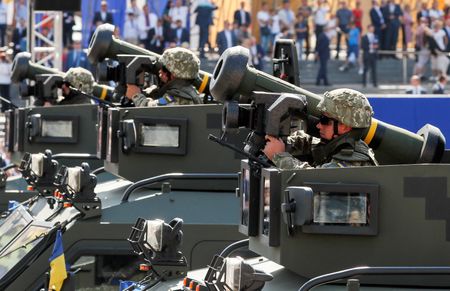
Ukraine’s Small Missiles vs The Big Invader

When Ukrainian President Volodymyr Zelensky told the world “I need ammunition, not a ride,” what he really wanted was anti-tank and anti-aircraft weapons.
Since then, countries have sent him some 17,000 anti-tank missiles and thousands of anti-aircraft missiles. Zelensky’s request, and the international response, reflect the missiles’ military suitability and political acceptability for Ukraine’s defence against more numerous Russian invaders. Outnumbered defenders When the war began, Russia had roughly five times more tanks and nine times more warplanes than Ukraine did.
Russia’s numerical superiority compared to Ukraine makes it impractical for Ukrainians to simply fight tank-versus-tank or plane-versus-plane. Anti-tank and anti-aircraft missiles partly make up the difference. Unlike the larger ballistic missiles fired between countries or cruise missiles fired by warships, Ukraine’s missiles are mostly small enough for individual soldiers to carry.
The technology works particularly well for defence. Soldiers basically point and shoot the missiles at targets they see. This can include armoured vehicles driving along roads or aircraft flying overhead. Ironically, Russia’s predecessor, the Soviet Union, was a leader in missile development. For example, Egypt used Soviet-supplied missiles to destroy Israeli tanks and aircraft during the 1973 war.
Today’s missiles cost tens or hundreds of thousands of dollars. But they can destroy tanks and warplanes costing millions or tens of millions more. That makes the missiles good for asymmetric “David and Goliath” situations, where one army is much smaller than its opponent. Impressive results Ukraine has apparently used its missiles and other weapons in a highly effective manner. It claims to be regularly destroying Russian warplanes, helicopters, tanks and other armoured vehicles.
A new internet meme has consequently appeared: “Saint Javelin of the Ukraine.” The image shows a woman wearing medieval clothes but carrying a Javelin anti-tank weapon. That’s an apparent nod to Saint Olga of Kiev, an Eastern Orthodox Church saint who protected her son and avenged her husband’s death in medieval Ukraine.
Ukraine’s success with the missiles has also prompted a darkly humorous announcement from Ukraine’s tax authorities: Captured Russian tanks won’t need to be declared as assets on income tax forms, because they’re clearly not worth much. Politically acceptable The missiles also have a diplomatic advantage. Their low cost and defensive usage make them politically easier for other countries to provide.
Not surprisingly, NATO members like Canada, the United Kingdom and the United States are sending missiles to Ukraine. But even traditionally neutral Sweden and Finland have provided some. By contrast, governments disagree about sending more expensive offensive weapons like warplanes. Admittedly, some countries are clearing out old inventories. The Soviet-made Strela anti-aircraft missiles coming from Germany were inherited from East Germany after reunification in 1990.
The M72 light anti-tank missiles from Canada were also designed during the Cold War, though they’re still being produced. They have limited utility against modern tanks but remain effective against other vehicles. Ukraine apparently has not received any larger vehicle-mounted missiles. It still hopes to get some from European countries to replenish its S-300 air defence systems.
The country had asked Israel for an Iron Dome rocket interception system. But those cost more than US$50 million each and Israel only has 10, so it declined the request. It’s possible the U.S. will offer its two Iron Domes. Missile countermeasures Like any weapon, however, Ukraine’s missiles have limitations.
Many Russian tanks have “reactive armour” that resembles metal bricks glued to the outside. When missiles hit, the armour explodes, thereby interfering with the missiles’ own detonations. In principle, anti-tank missiles can also be intercepted, much like any other missile. My own research has studied interceptors for cruise missiles at sea and ballistic rockets over land.
Russia has developed active protection systems that try to do this. They shoot down missiles just before they strike the vehicle. Israeli tanks carry similar systems. Aircraft instead try to throw incoming missiles off course. Burning flares and infrared jammers can confuse a missile’s heat-seeking guidance system. Other limitations Ukraine’s anti-tank and anti-aircraft missiles also face operational limitations.
They’re great at slowing down Russian forces heading into Ukraine. But they’re less helpful for pushing them out once after they’ve surrounded and begun bombarding cities like Mariupol. For that mission, Ukraine likely needs to counter-attack with tanks and airstrikes. And then they’ll face Russia’s own anti-tank and anti-aircraft missiles.
So even as other nations continue rushing missiles to Ukraine, the long-term odds against that country look formidable.
(The Conversation) AMS AMS
Disclaimer
The opinions expressed in this article are the author’s own and do not reflect the views of Chanakya Forum. All information provided in this article including timeliness, completeness, accuracy, suitability or validity of information referenced therein, is the sole responsibility of the author. www.chanakyaforum.com does not assume any responsibility for the same.
Chanakya Forum is now on . Click here to join our channel (@ChanakyaForum) and stay updated with the latest headlines and articles.
Important
We work round the clock to bring you the finest articles and updates from around the world. There is a team that works tirelessly to ensure that you have a seamless reading experience. But all this costs money. Please support us so that we keep doing what we do best. Happy Reading
Support Us





















POST COMMENTS (0)